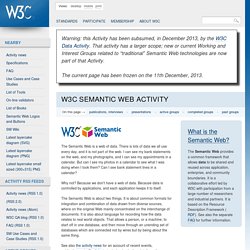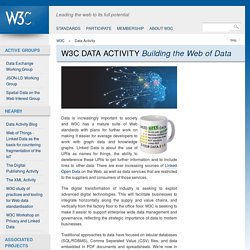

Karl Vanden Bogaert
Student @ Paris 8, Computer Science Interest's Fields: - Science - Technologies Job: Railway Signalling Projects
Le Web sémantique: mythe ou réalité ? The Semantic Web of Data Tim Berners-Lee. Web sémantique. Logo du W3C pour le Web sémantique Le Web sémantique, ou toile sémantique[1], est une extension du Web standardisée par le World Wide Web Consortium (W3C)[2].

Ces standards encouragent l'utilisation de formats de données et de protocoles d'échange normés sur le Web, en s'appuyant sur le modèle Resource Description Framework (RDF). Le web sémantique est par certains qualifié de web 3.0 . Alors que ses détracteurs ont mis en doute sa faisabilité, ses promoteurs font valoir que les applications réalisées par les chercheurs dans l'industrie, la biologie et les sciences humaines ont déjà prouvé la validité de ce nouveau concept[5].
L'article original de Tim Berners-Lee en 2001 dans le Scientific American a décrit une évolution attendue du Web existant vers un Web sémantique[6], mais cela n'a pas encore eu lieu. Histoire[modifier | modifier le code] Tim Berners-Lee à l'origine exprimait la vision du Web sémantique comme suit : — Tim Berners-Lee, Weaving the Web[13] — Weaving the Web[13] Sitographie. W3C Semantic Web Activity Homepage.
The Semantic Web is a web of data.

There is lots of data we all use every day, and it is not part of the web. I can see my bank statements on the web, and my photographs, and I can see my appointments in a calendar. But can I see my photos in a calendar to see what I was doing when I took them? Can I see bank statement lines in a calendar? Why not? The Semantic Web is about two things. See also the activity news for an account of recent events, publications, etc. The following groups are part of the Semantic Web Activity. Active Groups Semantic Web Coordination Group The Semantic Web Coordination Group is tasked to provide a forum for managing the interrelationships and interdependencies among groups focusing on standards and technologies that relate to this goals of the Semantic Web Activity. RDFa Working Group RDF Working Group The mission of the RDF Working Group, is to update the 2004 version of the Resource Description Framework (RDF) Recommendation.
Linked Data Platform Working Group. W3C Data Activity - Building the Web of Data. Data is increasingly important to society and W3C has a mature suite of Web standards with plans for further work on making it easier for average developers to work with graph data and knowledge graphs.

Linked Data is about the use of URIs as names for things, the ability to dereference these URIs to get further information and to include links to other data. There are ever increasing sources of Linked Open Data on the Web, as well as data services that are restricted to the suppliers and consumers of those services. The digital transformation of industry is seeking to exploit advanced digital technologies. This will facilitate businesses to integrate horizontally along the supply and value chains, and vertically from the factory floor to the office floor. W3C is seeking to make it easier to support enterprise wide data management and governance, reflecting the strategic importance of data to modern businesses.
W3C Data Activity. As many people who work in the field will know, the 2007 INSPIRE Directive tasks European Union Member States with harmonizing their spatial and environmental data.

The relevant department of the European Commission, the JRC, has lead the definition of a complex data model that is broken down into various themes. Naturally enough, the data is modeled in UML and the implementations are based largely on OGC standards that make use of XML/GML etc. However, a number of projects are experimenting with using the model in Linked Data environments. These include GeoKnow, MELODIES and SmartOpenData (SmOD) in which W3C’s European host, ERCIM, is a partner. This project has been instrumental in establishing the Spatial Data on the Web Working Group that is now racing towards the first formal publication of its use cases and requirements document (like most W3C WGs, the document is being developed in full public view on Github). Can they be added to? Certainly. How? Flux RSS (fr) Flux RSS (en)